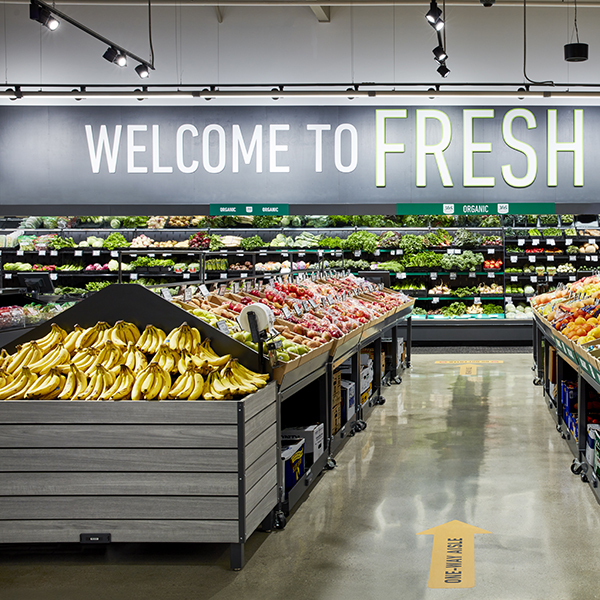Jeff Bezos, the founder of Amazon.com and its longtime CEO, is expected to continue to focus on building the company’s diverse food retailing operations as he transitions to his new role as executive chairman.
“While there hasn’t been a lot of attention focused on what Jeff Bezos will be working on as executive chair, I think it’s safe to say that one of the initiatives will be focused on winning in grocery,” said Bill Bishop, chief architect at Barrington, Illinois.-based consulting firm Brick Meets Click.
In Amazon’s recent fourth-quarter conference call with investors, Brian Olsavsky, chief financial officer, said Bezos will continue to be involved in “the more important decisions” at Amazon, which he said included “going into grocery.”
Stephanie Landry remains vice president of grocery at the company, and John Mackey remains CEO of Whole Foods Market, the 500-store chain he co-founded and which Amazon acquired in 2017.
Bishop said he sees Amazon building a huge physical network for fulfilling home delivery to affluent shoppers, and connecting that with its broader online retail offerings. The goal, he said, is to capture enough consumers “so that it has the delivery density and frequency to support a sustainable last-mile delivery system.”
The company has been laying the groundwork for this by positioning its Amazon Fresh stores and Prime Now distribution hubs to serve higher-income market areas, and leveraging the unlimited two-hour free delivery that comes with Prime membership, Bishop said.
In addition, as Amazon builds out its Amazon Fresh Prime network, the company will increasingly integrate it with Amazon.com to bolster the overall grocery offering, he said.
Bishop also expects the company to continue to expand its growing brick-and-mortar grocery footprint.
“There’s a good chance they’ll build more Amazon Go stores with an assortment that tilts toward grocery, and then tie all of their retail assets together — i.e.. Amazon Fresh, Amazon Go, and Whole Foods — to saturate the target market areas,” he said. “Once they have the customer base to generate enough delivery business, we expect that they will begin the shift from ad hoc delivery of individual orders to regularly scheduled delivery routes.”
This would provide a more efficient delivery system, he said, and would lay the foundation for home delivery of an array of retail products.
“This will be a Bezos initiative, and it will have an initial impact on grocery retailing and a broader impact on the whole retail sector over time,” Bishop said.
Threat From Amazon’s Own Brands
Jeff Grogg, managing director of JPG Resources, a Battle Creek, Michigan-based food-industry consulting firm, said Amazon’s growing own-brand portfolio looms as a potentially increasing threat to specialty food makers as the company expands its grocery operations.
Amazon’s ability to showcase its own brands online, or brands it has invested in, or brands it prefers to showcase for whatever reason, combined with the company’s dominance of the online retailing space, means that other brands could become less and less visible to online shoppers, he said.
“We are waiting for Amazon to be a little bit more of the 800-pound gorilla in the room than they have been,” said Grogg. “I would project that it is going to be less friendly to brands over time as Amazon really amplifies what they can do on their own.”
While it’s not clear yet exactly what Bezos’ role might be going forward, Grogg said Amazon has the resources and the technological capabilities to move faster in the grocery business if it chooses to do so.
“If they decide that they want to control the online shopping market more tightly, they will,” he said. “Tech companies usually are monopolists at heart — they buy or crush any successful competition.”
The current economic slowdown triggered by the pandemic will only create more demand for own-brand products, Grogg pointed out, creating a prime opportunity for a more aggressive move in that direction by Amazon in its grocery assortments.
“I don’t know if this is too different from where they were going to be in 10 years anyway, but they might end up there in two years instead of 10,” he said.
Brick-and-Mortar Leadership
In Amazon’s brick-and-mortar stores, the company’s experiments with self-checkout technologies could also result in a competitive advantage over rival retailers, Grogg said.
“Anything they can do to make the in-store experience better and make the checkout faster and more seamless is going to attract people,” he said.
Chuck Cerankosky, an analyst with Cleveland-based Northcoast Research, said he expects Amazon will continue to focus on the in-store experience at its Whole Foods locations.
“They seem to recognize that high-quality perishables will continue to grow in stores,” he said. “They know that the customer for those types of products — the ‘foodie’ — likes to select their own fresh foods, to a large extent.”
Whole Foods’ broad, high-quality assortments in the perishables departments continue to give the retail banner an edge over most traditional food retailers, Cerankosky said.
“I think those are differentiating qualities that Amazon wants to continue to nurture,” he said.
Related: Jeff Bezos Stepping Down as Amazon CEO; Amazon Fresh Opens Location.
Image: Amazon

